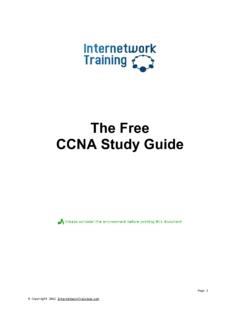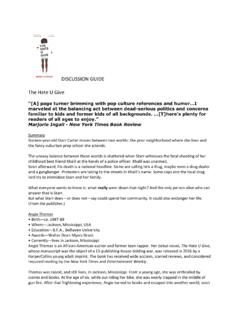Transcription of Chapter Easy Subnetting 4 - dginter.net
1 Chapter 4 Easy SubnettingThE FOLLOWING ICND1 ExAM TOPICS ARE COVERED IN ThIS Chapter :u1IP addressing (IPv4 / IPv6)u Describe the operation and necessity of using private and public IP addresses for IPv4 addressing We ll pick up right where we left off in the last Chapter and con-tinue to explore the world of IP addressing. I ll open this Chapter by telling you how to subnet an IP network an indispensably crucial skill that s central to mastering networking in general! Forewarned is forearmed, so prepare yourself because being able to subnet quickly and accurately is pretty challenging and you ll need time to practice what you ve learned to really nail it. So be patient and don t give up on this key aspect of networking until your skills are seriously sharp.
2 I m not kidding this Chapter is so important you should really just graft it into your brain! So be ready because we re going to hit the ground running and thoroughly cover IP Subnetting from the very start. And though I know this will sound weird to you, you ll be much better off if you just try to forget everything you ve learned about Subnetting before reading this Chapter especially if you ve been to an official Cisco or Microsoft class! I think these forms of special torture often do more harm than good and sometimes even scare people away from networking completely. Those that survive and persevere usually at least question the sanity of continuing to study in this field. If this is you, relax, breathe, and know that you ll find that the way I tackle the issue of Subnetting is relatively painless because I m going to show you a whole new, much easier method to conquer this monster!
3 After working through this Chapter , and I can t say this enough, after working through the extra study material at the end as well, you ll be able to tame the IP addressing/ Subnetting beast just don t give up! I promise that you ll be really glad you didn t. It s one of those things that once you get it down, you ll wonder why you used to think it was so hard! To find up-to-the minute updates for this Chapter , please see or the book s web page at BasicsIn Chapter 3, TCP/IP, you learned how to define and find the valid host ranges used in a Class A, Class B, and Class C network address by turning the host bits all off and then all on. This is very good, but here s the catch: you were defining only one network, as shown in Figure Subnetting Basics 141 FIGuRE One.
4 One large broadcast domain! By now you know that having one large network is not a good thing because the first three chapters you just read were veritably peppered with me incessantly telling you that! But how would you fix the out of control problem that Figure illustrates? Wouldn t it be nice to be able to break up that one, huge network address and create four manageable networks from it? You betcha it would, but to make that happen, you would need to apply the infamous trick of Subnetting because it s the best way to break up a giant network into a bunch of smaller ones. Take a look at Figure and see how this might Multiple networks connected are those addresses shown in the figure? Well that is what this Chapter will explain!
5 How to make one network into many networks!Let s take off from where we left in Chapter 3 and start working in the host section (host bits) of a network address, where we can borrow bits to create Chapter 4 u Easy SubnettingHow to Create SubnetsCreating subnetworks is essentially the act of taking bits from the host portion of the address and reserving them to define the subnet address instead. Clearly this will result in fewer bits being available for defining your hosts, which is something you ll always want to keep in in this Chapter , I ll guide you through the entire process of creating subnets starting with Class C addresses. As always in networking, before you actually implement anything, including Subnetting , you must first determine your current requirements and make sure to plan for future conditions as this first section, we ll be discussing classful routing, which refers to the fact that all hosts (nodes) in the network are using the exact same sub-net mask.
6 Later, when we move on to cover variable length subnet masks (VLSMs), I ll tell you all about classless routing, which is an environment wherein each network segment can use a different subnet to create a subnet, we ll start by fulfilling these three steps: 1. Determine the number of required network IDs:uuOne for each LAN subnetuuOne for each wide area network connection 2. Determine the number of required host IDs per subnet:uuOne for each TCP/IP hostuuOne for each router interface 3. Based on the above requirements, create the following:uuA unique subnet mask for your entire networkuuA unique subnet ID for each physical segmentuuA range of host IDs for each subnetSubnet MasksFor the subnet address scheme to work, every machine on the network must know which part of the host address will be used as the subnet address.
7 This condition is met by assign-ing a subnet mask to each machine. A subnet mask is a 32-bit value that allows the device that s receiving IP packets to distinguish the network ID portion of the IP address from the host ID portion of the IP address. This 32-bit subnet mask is composed of 1s and 0s, where the 1s represent the positions that refer to the network subnet addresses. Not all networks need subnets, and if not, it really means that they re using the default subnet mask, which is basically the same as saying that a network doesn t have a subnet address. Table shows the default subnet masks for Classes A, B, and C. Subnetting Basics 143 TABLE Default subnet maskClassFormatDefault Subnet you can use any mask in any way on an interface, typically it s not usually good to mess with the default masks.
8 In other words, you don t want to make a Class B subnet mask read , and some hosts won t even let you type it in. But these days, most devices will. For a Class A network, you wouldn t change the first byte in a subnet mask because it should read at a minimum. Similarly, you wouldn t assign because this is all 1s, which is a broadcast address. A Class B address starts with , and a Class C starts with , and for the CCNA especially, there is no reason to change the defaults!understanding the Powers of 2 Powers of 2 are important to understand and memorize for use with IP Subnetting . Review-ing powers of 2, remember that when you see a number noted with an exponent, it means you should multiply the number by itself as many times as the upper number specifies.
9 For example, 23 is 2 x 2 x 2, which equals 8. Here s a list of powers of 2 to commit to memory:21 = 222 = 423 = 824 = 1625 = 3226 = 6427 = 12828 = 25629 = 512210 = 1,024211 = 2,048212 = 4,096213 = 8,192214 = 16,384 Memorizing these powers of 2 is a good idea, but it s not absolutely necessary. Just remember that since you re working with powers of 2, each successive power of 2 is double the previous one. 144 Chapter 4 u Easy SubnettingIt works like this all you have to do to remember the value of 29 is to first know that 28 = 256. Why? Because when you double 2 to the eighth power (256), you get 29 (or 512). To deter-mine the value of 210, simply start at 28 = 256, and then double it can go the other way as well. If you needed to know what 26 is, for example, you just cut 256 in half two times: once to reach 27 and then one more time to reach Inter-Domain Routing (CIDR)Another term you need to familiarize yourself with is Classless Inter-Domain Routing (CIDR).
10 It s basically the method that Internet service providers (ISPs) use to allocate a number of addresses to a company, a home their customers. They provide addresses in a certain block size, something I ll talk about in greater detail you receive a block of addresses from an ISP, what you get will look something like this: This is telling you what your subnet mask is. The slash nota-tion (/) means how many bits are turned on (1s). Obviously, the maximum could only be /32 because a byte is 8 bits and there are 4 bytes in an IP address: (4 n 8 = 32). But keep in mind that regardless of the class of address, the largest subnet mask available relevant to the Cisco exam objectives can only be a /30 because you ve got to keep at least 2 bits for host , for example, a Class A default subnet mask, which is This tells us that the first byte of the subnet mask is all ones (1s), or 11111111.




